Thornapple
This deadly poisonous plant from the Nightshade family is usually only found in gardens and flower beds but you can come across it as an escapee in the wild as it is an aggressive weed.
| Hedgerow Type | |
| Common Names | Thornapple |
| Scientific Name | Datura stramonium |
| Season Start | Jun |
| Season End | Oct |
Leaves
Dark green on top, lighter underneath. The leaves are shiny and largely toothed or scalloped around the edges.
Flowers
White, long and trumpet shaped ending in five points emerging from a fairly long green calyx.
Seed Pods
A conker like spikey green pod which splits into four releasing the seeds. Can be found with spineless ‘conkers’.
Habitat
Mainly planted in formal gardens and flowerbeds but can occasionally be found elsewhere when it has escaped.
Smell
Thornapple is described as foul smelling.
Frequency
Uncommon.
Medicinal Uses
Was used as an analgesic by some ancient cultures and in Europe it was used as an anti-inflammatory particularly for haemorrhoids and also used to treat epilepsy and convulsions.
Other Facts
Thornapple has been used by South American shamens to enter altered states and also as a recreational drug producing hallucinations but both shamen and recreational users have died using Thornapple as its toxic tropane alkaloids atropine, hyoscyamine and scopolamine can vary in amount and ratio from plant to plant.

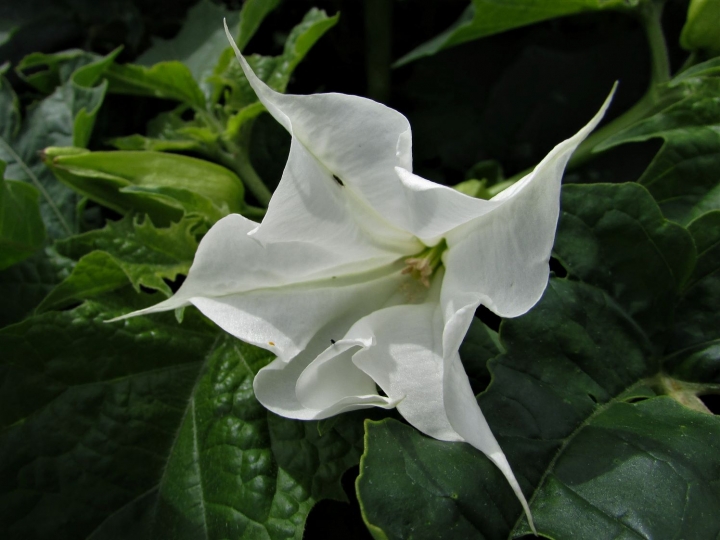
















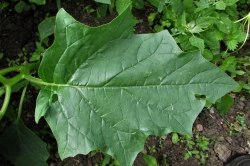
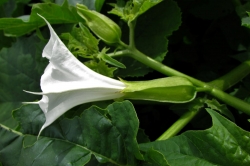
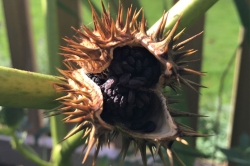
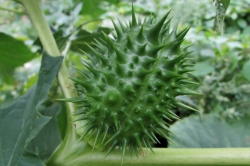
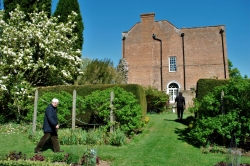





18 comments for Thornapple
Thank you so very much. I found this “thorn apple “ growing in my yard under a walnut tree. It was unusual so I asked a friend by sending a photo. She referred me to your institution.
I found this plant in the middle of my garden and had no idea what it was or how it ended up in a garden that hasn’t been added to in years. It looks healthy and stands about 2.5 feet tall. I was happy to see it will eventually flower.
I found this plant in my garden and it’s extremely large. The stems are almost tree like. After reading about this plant I’m concerned for the safety of me and my pets. Please tell me how to get rid of this plant or will it die on its own and not return
It can not cause poisoning unless ingested so I would leave it alone. If it must be removed it should be cut back to ground level and the stump removed.
Can it be brought in by birds
Birds can be responsible for spreading this plant and the seeds can stay viable for years until the perfect conditions.
Found growing between paving and wall in area where birds are fed with seeds.In Nottinghamshire.
Can the sap or moisture for the stem poison you? I pulled it out with bare hands not realizing how poisonous it is. Will I be ok?
If you got a fair amount of sap in an open wound, you may not feel too good but just handling the plant won’t cause any issues.
Found today in my allotment in Durham was just growing in the potato patch should I leave it or destroy ???
I would leave it to grow, just don’t consume any of the plant.
Why would anyone with half a brain want to destroy such anexotic and beautiful plant. Just leave it be. It,s not a danger to anyone, unlike the deadly nightshade, whose fruit can be a temptation to children.
Is it poisonous to children If pricked my it’s thorns ?
The thorns don’t carry venom so it would not cause poisoning.
I came here after a search related to a reddit post where someone was being strongly advised NOT to use them as a psychedelic. I personally know someone who lost a limb after an accident involving datura seeds. 1/10 would not recommend 🙂
In 1990 I collected datura seeds in the USA and kept them for a while. A few years ago I gave some of them to a friend who had expressed an interest in experimenting with these seeds. As he had already told me that he had taken other drugs and had suffered no serious ill effects I had no worries on his behalf. He later told me that everything turned orange after he had swallowed a heavy dose. When I saw him just a few months ago he added that he had come close to serious injury. In Asia ‘ thugees’ used datura to render their victims comatose so that they could be robbed. I recommend that anyone taking datura for recreational purpose start with a very small dose.
Personally I would not keep this plant growing in my garden if I had children, pets or growing any type of crop. you cannot guarantee safety whilst this is nearby. it is a shame, beautiful flowers.
While in Hungary last October I saw many datura stramonium plants from my train window, which delighted me, as I am a great fan. A bit later on, while staying in Constantia, on the Black Sea in Romania, I was thrilled to find a huge datura wrightii growing in a sheltered corner of a vacant lot. I didn’t know what it was until I looked it up on my phone, when I discovered that it is a native of California and Mexico !! How it found itself on the Black Sea I have no idea. Perhaps it was a garden escape. It is certainly a more handsome plant than its cousin, with beautiful greyish-green oval, rather than toothed, leaves, and with rather longer white trumpet flowers. It was still flowering in early November, so must have loved its sunny position. I took some seeds home and am now growing daturia wrightii in my garden. Result !